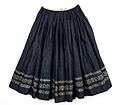Folk costumes of Podhale
Folk costumes from Podhale region - costumes wear by Highlanders (Gorals) in Polish area of the Tatra Mountains, Podhale region.[1] Unlike other regional groups in Poland, Highlanders from Podhale wear traditional outfit (or its elements) on a daily basis. This type of outfit is widely considered one of the Polish national costumes.[2]


Male attire
The most important elements of male attire are: trousers (portki) and a coat (cucha) made of woollen broadcloth, a leather vest (serdak), moccasins (kierpce) and a belt (trzos, opaska), shirt (koszula) made of homespun flaxen cloth and a black felt hat.[3]
Female attire
Female attire has been changed through the 19th and 20th century and in mid-19th century consisted of a percale shirt with wide sleeves, a decorated corset made of fabric, a wide percale skirt with floral motif, a muslin apron (fartuch), boots with high soles, trinkets or coral necklaces around the neck and a muslin (or tybet, or woollen) scarf worn on the head or over the shoulders. Women also wear the same type of shoes as man do - kierpce.[3]
Gallery
- Traditional Men`s Clothing from Podhale region
 Traditional man's attire from Podhale region - back, with a hat (from the Tatra Museum's collection) - back view.
Traditional man's attire from Podhale region - back, with a hat (from the Tatra Museum's collection) - back view. Traditional man's attire from Podhale region (from the Tatra Museum's collection) - front view.
Traditional man's attire from Podhale region (from the Tatra Museum's collection) - front view. Traditional man's coat ('gunia', 'cucha') from Podhale region (from the Tatra Museum's collection)
Traditional man's coat ('gunia', 'cucha') from Podhale region (from the Tatra Museum's collection) Details of the man's costume from Podhale region: traditional belt and 'parzenica' embroidery on trousers.
Details of the man's costume from Podhale region: traditional belt and 'parzenica' embroidery on trousers.
- Traditional Women`s Clothing from Podhale region
 Traditional woman's attire from Podhale region (from the collection of the Tatra Museum in Zakopane) - front view.
Traditional woman's attire from Podhale region (from the collection of the Tatra Museum in Zakopane) - front view. Traditional skirt from Podhale region (from the collection of Tatra Museum in Zakopane)
Traditional skirt from Podhale region (from the collection of Tatra Museum in Zakopane) Traditional woman's attire from Podhale region (from the Tatra Museum's collection) - back view.
Traditional woman's attire from Podhale region (from the Tatra Museum's collection) - back view..jpg) Woman's traditional corset - Podhale region (from the Tatra Museum's collection).
Woman's traditional corset - Podhale region (from the Tatra Museum's collection).
References
- Gwozdz, Cathy (1985). Costumes of the Polish Highlanders. Polish Highlanders Association of Canada.
- Condra, Jill (2013). Encyclopedia of National Dress: Traditional Clothing Around the World. ABC-CLIO. p. 601. ISBN 0313376379.
- Hermanowicz-Nowak, Krystyna (2014). "The Costume". Ethnologia Polona - Carpathian Reminiscences. Institute of Archeology and Ethnology Polish Academy of Science. 35: 101–123.